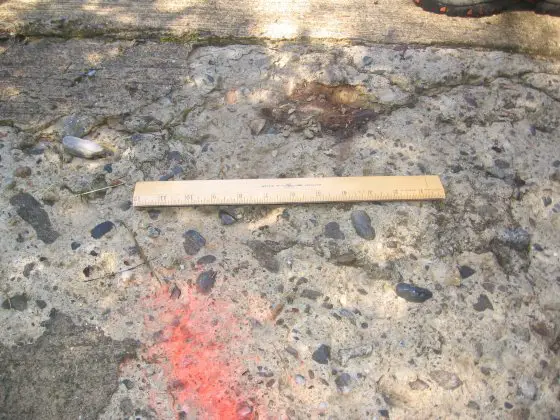
This is badly spalled concrete. It’s not a candidate for an epoxy coating but one wonders if epoxy is the best choice in the first place. Copyright 2020 Tim Carter
DEAR TIM: I’ve got problems with some of the concrete on the outside of my home as well as in my garage. There are lots of places where the top finish and layer of the concrete has eroded away. I think it’s called spalling. It’s worse in some areas than others. My biggest question is if I should transform my concrete garage floor by installing a fancy epoxy coating. They look marvelous in my opinion. What are the pros and cons of this? How would you repair all the other wretched concrete outdoors? Steve H., Sylvania, OH
There’s a really good chance you have unsightly concrete as Steve does. It’s somewhat common and if my incoming email is any indication, it’s a worsening and chronic problem for tens of thousands of homeowners and business owners.
Let’s discuss first a few of the primary reasons why it happens to your concrete but other concrete nearby is immune to this damage. That should be your first clue that it’s probably a workmanship defect, and not something inherently wrong with the concrete itself.
Concrete is simply artificial rock. Three of the four ingredients in basic concrete are or were rock at one point. The aggregate, or stones, are solid rock. The sand in concrete is thousands of small tiny pieces of rock in almost all cases. Some sand is crushed seashells, but this is rare. The Portland cement is powdered rock, primarily limestone and shale. The only ingredient that’s not rock is water. You need the water to ignite the chemical reaction that transforms the powdered Portland cement back into solid rock again.
Here are just a few things that can go wrong with concrete that can cause spalling and the surface to flake off. First, the concrete can be mixed wrong with not enough Portland cement. Too much water can be added making it to watery. Water can be added during the finishing process that dilutes the amount of Portland cement in the top layer of the concrete. The concrete may not have been cured immediately after the finishing process ended.
There’s a common misconception that deicing salts are responsible for ruining concrete and cause it to spall. The facts prove otherwise. What I mean is that you undoubtedly have seen lots of concrete sidewalks, floors, patios, etc. that have had years of deicing salt on them, yet there’s no spalling. Why is that?
The reason that concrete survived the deicing salts is it was mixed, placed, finished, and cured properly. Deicing salts can damage weak concrete just like the big bad wolf blew down the straw house made by the little piggy.
Think about your concrete garage floor for a minute. Imagine it brand new and how good it looked. It’s maintenance-free for the most part, right? You just keep it clean with soap and water and it looks amazing for years.
If you decide to apply one of the many magnificent epoxy coatings, you introduce a wildcard into the equation. You hope that the epoxy will hold and won’t peel in places. You hope you’ll do everything right during the installation process, a process you’ve never done before I might add! You possibly create a new surface that requires more work to keep looking nice than your plain-vanilla concrete slab. On a personal note, I’d never install an epoxy finish because I don’t want more maintenance.
You can repair and resurface your spalled concrete in any number of ways. You can buy products that apply a very thin coating on the concrete. The larger pre-mixed bagged concrete manufacturers make these as well as some other specialty companies. These products do work but pay close attention to their limitations.
Deeply spalled concrete can be repaired with a concrete overlay. Think of this as just applying stucco to the concrete. You just mix up some sand, a little hydrated lime, and Portland cement and trowel this onto the concrete. To get this stucco to bond permanently to the spalled concrete, the old concrete must be clean and solid with all of the loose concrete chipped away.
A very important step, taught to me by a very old and wise concrete mason decades ago, is to apply a very thin coat of cement paint to the old concrete before applying the stucco. You want to spritz the old concrete with a little water to make it damp before applying the Portland cement that you mixed with clean water to the consistency of regular paint. It’s important to immediately cover the wet cement paint with the stucco mix.
Realize concrete overlays can range in thickness from 1/8-inch all the way to 1 or 2 inches. As the overlay gets thicker, you need to increase the size of the sand being used. Once the overlay approaches 3/4-inch inch in thickness, you can introduce tiny pieces of pea gravel about the size of a pencil eraser.
Column 1349
The post Epoxy Garage Floor Coatings – Should I? appeared first on Ask the Builder.
Via builders feed http://www.rssmix.com/
No comments:
Post a Comment